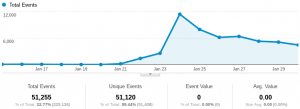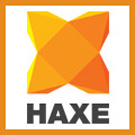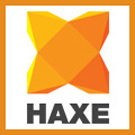![]() Sometime today Gold Leader crossed 50,000 unique viewers. Together they’ve played just under 76,000 times over the two weeks it’s been released.
Sometime today Gold Leader crossed 50,000 unique viewers. Together they’ve played just under 76,000 times over the two weeks it’s been released.
Of course, “unique” is not a strictly literal term. I’m not sure how Google Analytics determines uniqueness exactly, but people coming back after some time are clearly included. In some sense that doesn’t matter much in terms of counting eyeballs for ads and such and there’s no other real mechanism without any sort of accounts or such, so that’s the kind of number that generally gets bandied about.
As noted by the stats on the main blog, the game remains much too hard: Only about 14% of all players are beating the first mission objective. I can only imagine what that’s doing to the repeat plays, or presumed lack thereof. About 4000 people have loaded the game and not started a mission. I guess it just wasn’t what they’re looking for.
Almost all of the plays actually come from the last week. The first week after launch (Jan 16) the game was getting a steady thousand views/day or so on GameShed. Once it went viral to all the ridiculously many Flash sites around the net though, the plays spiked quite dramatically (about Jan 22). Views are trending down now as the game falls off their front pages, but I really have no idea what the lifetime is. Hopefully it settles on some sort of steady number of plays and doesn’t bottom out completely though it’s hard to believe that won’t happen given the steady deluge of games hitting the Web.
I’ve had some trouble coming up with numbers for typical Flash game plays so I’m not sure how this compares. Many sponsors don’t allow developers to collect stats, and many developers are cagey about revealing what they do know. Clearly it’s no Angry Birds or even a moderate hit, but it also certainly doesn’t seem to be the bottom of the barrel either.
Either way, that’s a pretty satisfying number and was actually my admittedly under-informed target: 50,000 players in two weeks. 50,000 people is a lot of people! I guess it’s not “Internet scale,” but even accounting for some reasonable fraction being repeat players that’s still an absurd amount of people to have played my little shoot ’em up.
To put it in one perspective of interest to me, I’ve published research articles in several high profile venues, most notably in terms of numbers some of the major IEEE magazines such as Internet Computing. An optimistic readership number I’ve heard for those higher profile venues is 5000 people, and presumably some fraction thereof reading any given individual article. This is an order of magnitude more! And it’s god knows how far from putting games up on the Web ten to fifteen years ago, when I was probably optimistically getting a very low couple hundred players, mostly through the Allegro community.
For the most part this is actually not as emotional as some of the early super enthusiastic reviews on FGL, but it’s still really cool and deeply rewarding. It’s also somewhat educational. Though fairly obvious beforehand, the data confirms that even for a lower profile game like this, the resources consumed would be pretty substantial for a single host. If I moved the leaderboard or analytics off Mochi and Google, or provided any kind of multiplayer, online updates, or downloadable content, I would need some serious infrastructure to manage it. Fortunately, I’m on top of it. To the future!

 Some updated notes on
Some updated notes on  Recently
Recently 